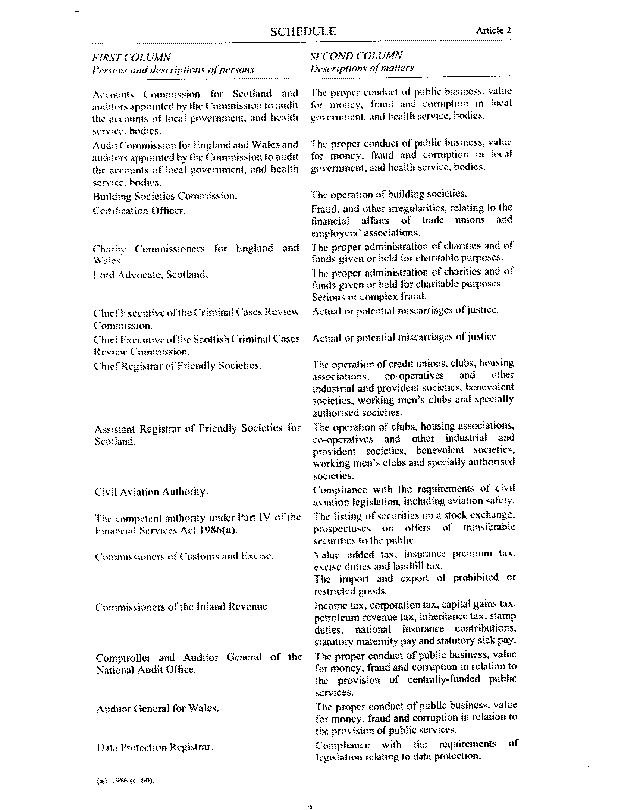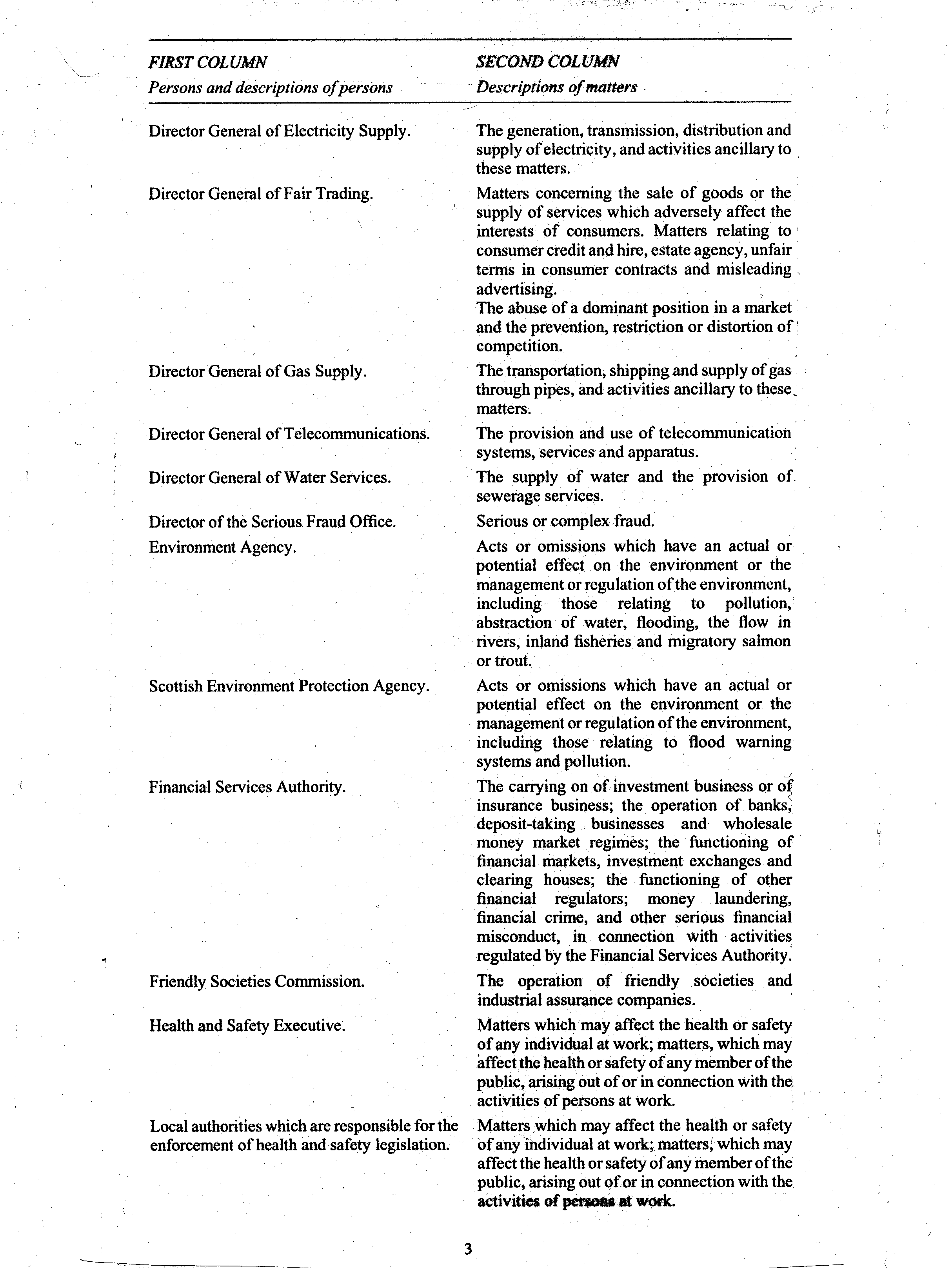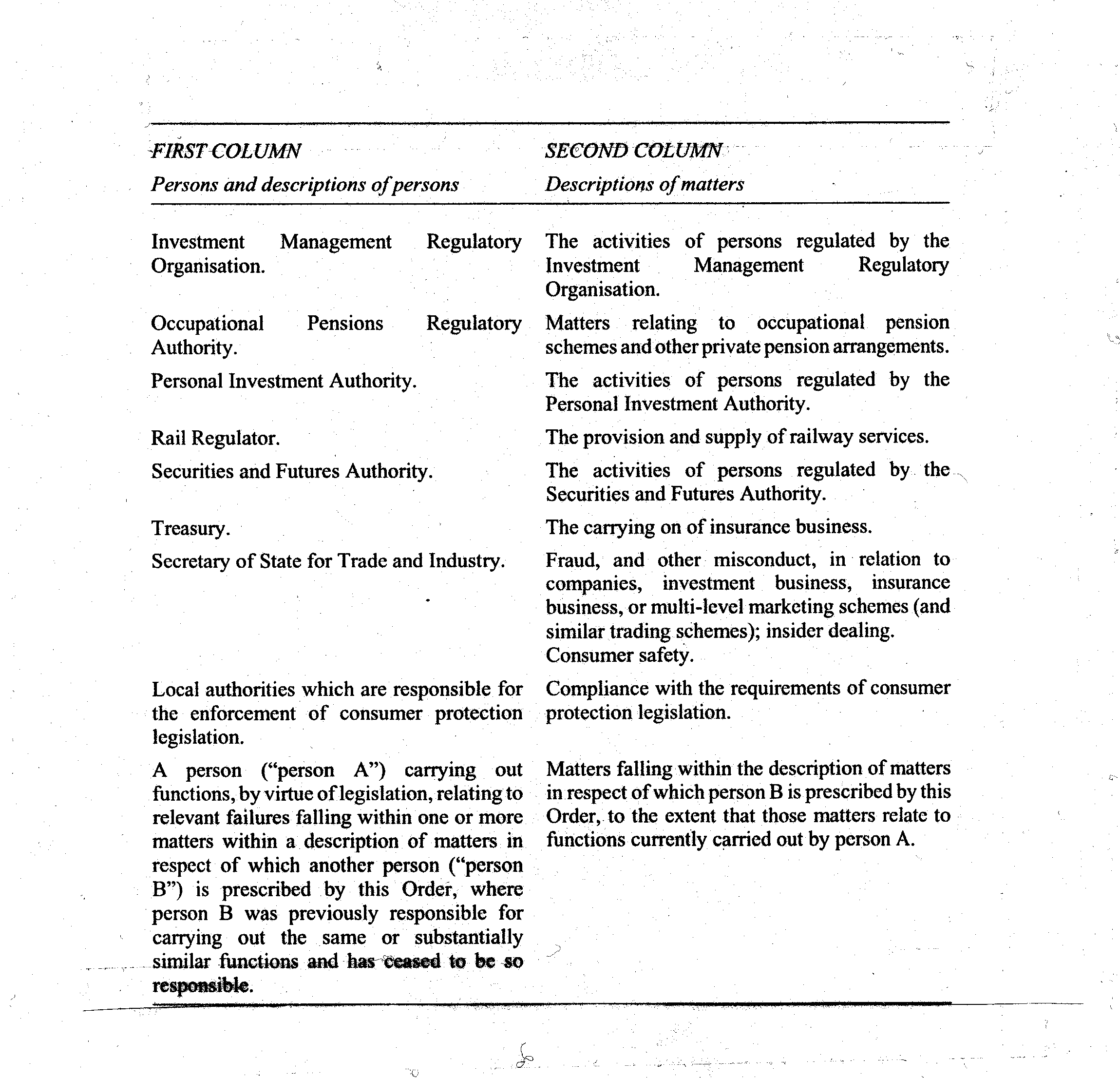PRB 99-39E
LEGISLATIVE PROTECTION FOR
Prepared by: TABLE OF CONTENTS LEGISLATIVE PROTECTION FOR WHISTLEBLOWERS IN BRITAIN
The term "whistleblower" is frequently used to describe an employee who discloses wrongdoing within an organization, by either the employer or a fellow employee. After having made a disclosure, the whistleblower may suffer retaliation by being dismissed, demoted or punished in some other way. The main purpose of whistleblower protection legislation is to safeguard employees who blow the whistle against these kinds of employment reprisals. Not only does such legislation encourage whistleblowers to come forward with information on wrongdoing, but it also discourages wrongdoing because of the increased risk of being found out. In Canada, as in certain other jurisdictions, most notably the United States, a number of statutes, particularly those covering environmental or occupational health and safety matters, protect whistleblowers who report misdeeds under the statutes. Governments in Canada, however, at both the federal and provincial levels, have thus far generally declined to enact broader whistleblower protection legislation for either public sector or private sector employees.(1) In the United States, legislation at the federal level applies to public sector employees; legislation in many of the States applies primarily to public sector employees but in some cases to private sector employees as well. Britain is one example of a Commonwealth jurisdiction where, until recently, whistleblowers were in much the same position as in Canada; legislation existed to protect whistleblowers in certain limited situations. However, there was no equivalent to the formal complaint system established in the United States through specialized whistleblowing legislation. An observer once described the situation in Britain as "a combination of restrictive government guidelines and inadequate legal protection [which] conspire to silence any employee from revealing matters of public concern and leave the employer free to punish them."(2) Operating under legal constraints, courts did not generally have the power to protect whistleblowers against employment reprisals. In response to the limited protection available to legitimate whistleblowers, a number of support groups and services, such as Freedom to Care and Public Concern at Work, were established.(3) However, with the coming into force, on 2 July 1999, of the Public Interest Disclosure Act 1998 (hereinafter referred to as the PIDA 1998), the legal situation regarding whistleblowers in Britain has totally changed; it appears that they may now be among the best protected in the world. Following is a description of the legislation which generally sets out the persons who are protected, with respect to what kinds of disclosures, and in what circumstances. The PIDA 1998 consists of 18 sections, most of which add new sections to, or amend current sections of, Britain’s Employment Rights Act 1996(4) (hereinafter referred to as the ERA 1996). Subject to limited exceptions, the PIDA 1998 protects workers under contracts of employment (i.e., employees, including Crown servants); those who work personally for someone else (under a "worker’s" contract) but who are not genuinely self-employed; homeworkers; certain agency workers; National Health Service (NHS) professionals such as general practitioners, certain dentists, pharmacists and opticians; and certain categories of trainees.(5) Generally, the only workers who are not protected under the legislation are those who are genuinely self-employed, volunteers, police officers, those ordinarily working outside Britain, and those in the armed forces or in the security or intelligence services.(6) Section 1, the main provision of the PIDA 1998, inserts a new Part IVA entitled PROTECTED DISCLOSURES (comprising sections 43A to 43L) into the ERA 1996. Section 43A describes a "protected disclosure" as a "qualifying disclosure" that is made by a worker in accordance with any of sections 43C to 43H. A "qualifying disclosure" as defined in section 43B(1) contains information that, in the reasonable belief of the worker, suggests the occurrence now, in the past, or in the future, of one of the following:
For the purposes of the above, it is immaterial whether the relevant incident took place in the United Kingdom or elsewhere or whether the law applying to it is the law of the United Kingdom or any other country (section 43B(2)). As well, worker disclosure is not deemed to be a qualifying disclosure if by making it the worker commits an offence; an example would be if the disclosure was prohibited under the Official Secrets Act 1989 (section 43B(3)). Where the information is protected against disclosure because of legal professional privilege, and the person disclosing it has received the information from someone seeking legal advice, the disclosure is not a qualifying disclosure (section 43B(4)). In order for a "qualifying disclosure" to constitute a "protected disclosure" certain requirements of sections 43C to 43H of the ERA 1996 must be met; these generally have three aspects:
According to section 43C of the ERA 1996, a qualifying disclosure is protected provided it is made in good faith to the worker’s employer (either directly or in accordance with a procedure authorized by the employer for that purpose) or to another person who the worker reasonably believes to be legally responsible for the relevant failure. There is no other requirement. Presumably, where an employer has an internal, readily accessible procedure that employees are encouraged to use, concerns are more likely to be disclosed first to the employer, rather than to an outside party. Pursuant to section 43D of the ERA 1996, a qualifying disclosure is deemed protected if it is made in the course of obtaining legal advice. There are no other conditions attached. A qualifying disclosure is deemed protected if it is made in good faith by a worker to a Minister of the Crown where the worker’s employer is an individual appointed under any statute by a Minister of the Crown, or a body whose members are so appointed (section 43E). Section 43F(1) of the ERA 1996 protects a qualifying disclosure made in good faith by the worker to a person listed in an order made by the Secretary of State for the purposes of the section, where the worker reasonably believes that this is the correct person to receive the allegations and that these allegations are substantially true. The Public Interest Disclosure (Prescribed Persons) Order 1999(7) prescribes the appropriate persons and bodies and the matters that can be disclosed to them (section 43F(2)). A copy of the Order is included as an Appendix to this paper. For example, breaches of health and safety regulations can be brought to the attention of the Health and Safety Executive or to the local authority responsible for the enforcement of health and safety legislation, while environmental dangers can be brought to the attention of the Environment Agency. According to section 43G of the ERA 1996, a qualifying disclosure is a protected disclosure provided that the worker makes it in good faith and without hope of personal gain, and reasonably believes that the information disclosed, and the allegations contained in it, are substantially true. In addition, one or more of the following conditions must be met:
Finally, in all the circumstances of the case, it must be "reasonable" for the worker to make the disclosure, having regard to:
Section 43H of the ERA 1996 stipulates that a qualifying disclosure is a protected disclosure for purposes of the provision if:
Any provision in an agreement between a worker and his or her employer that precludes the worker from making a protected disclosure under the Act is void. This includes an agreement to refrain from instituting any proceedings under the Public Interest Disclosure Act 1998 or any proceedings for breach of contract.(8) A worker has the right not to be subjected to any detriment by his or her employer for having made a protected disclosure(9) and can file a complaint with an employment tribunal if subjected to a detriment for such reason.(10) A detriment may take a number of forms, such as denial of promotion, facilities or training opportunities that the employer would otherwise have made available. Employees protected by the provisions who are dismissed for making a protected disclosure may make a claim for unfair dismissal. Workers who are not employees may not claim unfair dismissal if their contracts have been terminated because they have made a protected disclosure; however, they can make a complaint that they have been subjected to a detriment.(11) Where an employment tribunal finds that an employee’s complaint of unfair dismissal is justified, it will order re-instatement or re-employment, or the payment of compensation.(12) Where a worker who is not an employee makes a complaint that he or she has been subjected to a detriment and the tribunal finds the complaint to be well-founded, it will make a declaration to that effect and may order the payment of compensation.(13) Prior to the coming into force of the PIDA 1998, whistleblowers in Britain were not generally protected against employment reprisals. Operating under legal constraints, British courts did not have the power to provide such protection. The reason that legislation on the subject was not enacted until now was apparently because of "fears that it would lead to an epidemic of disloyal and aggrieved workers ‘ratting’ on their bosses about every perceived irregularity."(14) It has been observed that, in fact, the Act encourages workers to raise their concerns first with their employers and that it provides no protection for those workers who fail to act responsibly and reasonably. According to one commentator, "employers can dramatically reduce the risk that there will be an embarrassing public disclosure by implementing effective whistleblowing policies, thereby demonstrating to their workers a clear commitment to eradicate malpractice in the workplace."(15) Since the legislation has been in force for only a short period of time, it is too early to know the types of problems that might arise under the Act or what developments in case law could affect the rights of whistleblowers under the legislation. In any event, the Act appears to provide much needed legal protection for whistleblowers in Britain by ensuring that problems are brought to the attention of the appropriate person while at the same time encouraging whistleblowers themselves to act responsibly.
(1) The writer is aware of only one Canadian jurisdiction where specific legislation on the subject is in force; see section 28 of New Brunswick’s Employment Standards Act, which applies to both public and private sector employees. In December 1993, Ontario enacted specific legislation on the subject to protect public sector employees (Part IV of Ontario’s Public Service Act) but this has never been proclaimed in force. (2) J. Cooper and D. Green, "Whistleblowers," Solicitors Journal, 20 November 1992, p. 1166. (3) As described in: Australia, Senate Select Committee on Public Interest Whistleblowing, In the Public Interest, 1994, p. 21-4. (4) 1996 chapter 18: http://www.legislation.hmso.gov.uk/acts/acts1996/1996018.htm. (5) For a definition of a "worker" for purposes of Part IVA of the ERA 1996, see section 1 of the PIDA 1998 adding, among other new sections, section 43K to the ERA 1996; also see section 10 of the PIDA 1998 amending section 191 of the ERA 1996 (Crown employment). (6) See generally, section 11 of the PIDA 1998 amending section 193 of the ERA 1996; section 12 of the PIDA 1998 amending section 196 of the ERA 1996; and section 13 of the PIDA 1998 amending section 200 of the ERA 1996. (7) Britain, Statutory Instruments 1999 No. 1549. (8) Section 1 of the PIDA 1998 adding section 43J to the ERA 1996. (9) Section 2 of the PIDA 1998 adding section 47B to the ERA 1996. (10) Section 3 of the PIDA 1998 amending section 48 of the ERA 1996. (11) Guide to the Public Interest Disclosure Act 1998. (12) Ibid; see also section 8 of the PIDA 1998 amending sections 112, 117, 118 and adding section 127B to ERA 1996. Calculation of the amount of compensation for employees dismissed for making a protected disclosure is done as prescribed by regulation. (13) Ibid., see also section 4 of the PIDA 1998 amending section 49 of the ERA 1996 and placing a limit on the amount of compensation available in such a case. (14) C. Camp, "Openness and Accountability in the Workplace," New Law Journal, Vol. 149, January 1999, p. 46 at p. 50. (15) Ibid. |



